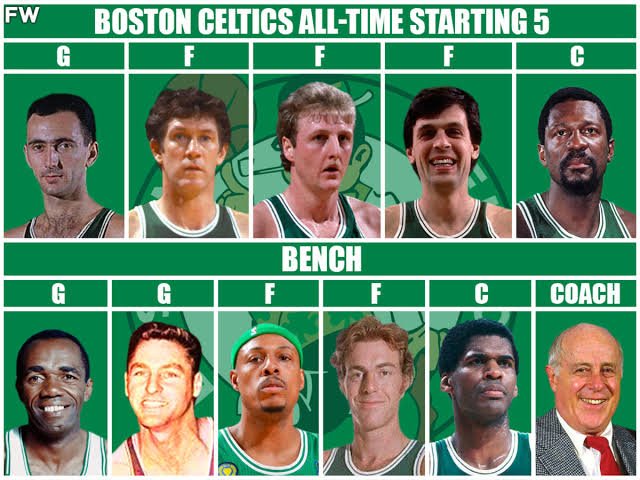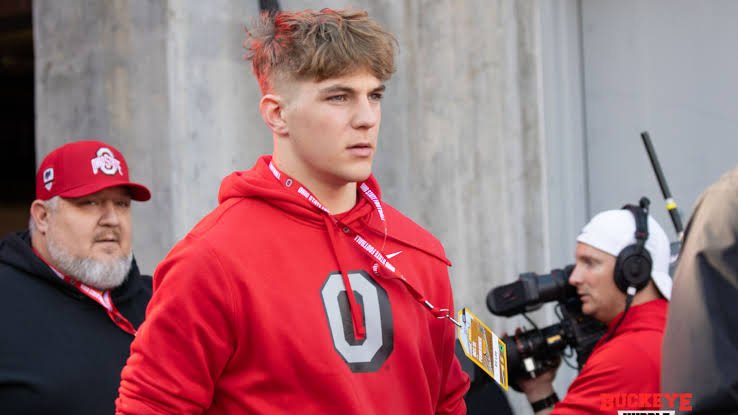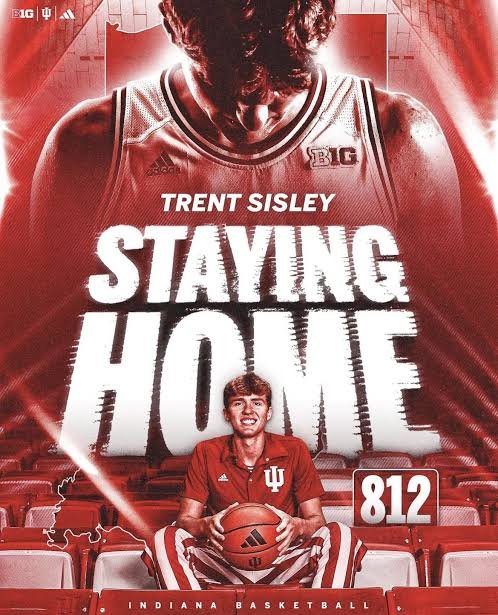All-Time Starting Lineup, Bench, and Coach for the Boston Celtics
All-Time Starting Lineup, Bench, and Coach for the Boston Celtics.

Among the NBA’s most illustrious clubs are the Boston Celtics. Since the team’s founding on June 9, 1946, just one thing has been associated with them: success. With 17 NBA titles, the guys from Beantown have the most in NBA history, tied with the Los Angeles Lakers. With 21, they are second only to Los Angeles in conference championships won. Some of the greatest players in league history have worn green and white, from their dominance in the 1960s when they won nine championships in that decade to their current situation where they are just two games away from winning their 18th Larry O’Brien trophy.
It is simple to overlook players who should be included because there are so many legends associated with a single organization. Even if they weren’t included here, players like Jo Jo White, Ray Allen, Dennis Johnson, and Kevin Garnett should still be acknowledged for their contributions to the team. Without a question, the roster we have assembled today is the best one we could have created. It’s stacked with champs, All-NBA players, and MVPs. More significantly, the tale of the Boston Celtics would not be possible without these players.
Bob Cousy, guard.
Titles: 6
Career averages: 5.2 RPG, 7.5 APG, and 18.4 PPG
1 MVP, 13 All-Stars, 2 All-Star Game MVPs, 12 All-NBA Team Selections, and Hall of Fame inductees (with the Celtics)
Bob Cousy was not always a Celtic, despite popular belief. His initial team, the Chicago Stags, broke up prior to Cousy’s 1950 rookie campaign. Boston will always be grateful to him for landing the Celtics in a dispersal draft. Cousy, also known as “The Houdini Of The Hardwood,” dazzled crowds with back-of-the-head dribbles and passes that gave the impression that he had eyes in the back of his head. He averaged 15.6 PPG (10th in the NBA) and 4.9 APG (4th) in his first campaign. Cousy’s play enhanced the Celtics’ record from the previous campaign.
Bob Cousy took off after Coach Red Auerbach unlocked the playbook. Eight times during his 13-year tenure in Boston, Cousy topped the league in assists. He also placed in the top 10 in scoring five times throughout those eight seasons. One of the NBA’s first authentic showmen with the ball in his hands, Cousy was a true pass-first player. But he was just as good at scoring, as he could outmuscle opponents or make short jumpers when his teammates couldn’t get open. The driving force behind six Boston Celtics championship runs was him because of his inventiveness and tenacity on the floor.
Leading man: John Havlicek.
Coach Red Auerbach unleashed the playbook, and Bob Cousy took off. Throughout his 13-year stay in Boston, Cousy led the NBA in assists eight times. During those eight seasons, he scored five goals and finished in the top 10. Cousy was a true pass-first player and one of the NBA’s first real showmen with the ball in his hands. He could outmuscle opponents or make short jumpers when his teammates couldn’t get open, but he was just as adept at getting points. He was the inspiration behind six Boston Celtics championship campaigns thanks to his creativity and perseverance on the court.
The main actor is John Havlicek.
He was a real swingman, as quick as guards and as strong as other small forwards thanks to his combination of strength and speed. Havlicek took charge of games off the bench as the Celtics dominated the 1960s; he wasn’t a starter, but he was generally on the court to close out games. Strong clutch instincts led him to be called upon during the most crucial times of a game, and he delivered. He was an important veteran presence on two more Celtics championship drives in 1974 and 1976. In 1974, he averaged 22.6 PPG and 6.4 RPG. On his way to winning the championship, he scored over 27.0 PPG. He was one of the most dedicated players in Boston history, a fierce competitor, and the epitome of a winner.
Larry Bird, moving forward.
Three championships
Career statistics: 10.0 RPG, 6.3 APG, 1.7 SPG, 0.8 BPG, 24.3 PPG,
Achievements (with the Celtics): Rookie of the Year, MVP three times, MVP two times, One All-Star Game MVP, twelve All-Stars, Hall of Fame, four-time All-Defensive Team selection, and ten-time All-NBA team selection
When it came to basketball, Larry Bird could do it all. In addition to scoring and rebounding, he was capable of about any other action you could imagine. The finest thing is that he could accomplish it while forewarning you about what he planned to do. His play contributed to his reputation as the “Larry Legend,” as did his legendary trash-talking. Bird was a unique talent, and it is said that his 1980s rivalry with Magic Johnson prevented the NBA from collapsing.
Bird’s contribution was immediately apparent as he helped the Celtics win 32 more games during his first campaign. In terms of minutes played, steals, rebounds, and scoring, he also topped the squad. Bird’s second season, 1981, saw the Celtics win an NBA championship, with Larry leading the way with 21.2 points per game and 10.9 rebounds. With Bird winning Finals MVP with 27.4 PPG and 14.0 RPG, the Celtics would win another title in 1984. The fact that the win came against Magic Johnson, his fierce adversary, and the Los Angeles Lakers, just to its sweetness. In 1987, Bird defeated the Rockets once more to capture his final championship and the title of Finals MVP of his career. 24.0 PPG, 9.7 RPG, and 9.5 APG on average were his.
Three championships
17.9 PPG, 7.3 RPG, 1.7 APG, 0.4 SPG, and 1.7 BPG are career statistics.
Accomplishments (with the Celtics): 7 times All-Star, 2 times Sixth Man of the Year, 1 time All-NBA Team, 6 times All-Defensive Team, and inducted into the Hall of Fame
Kevin McHale, another outstanding sixth man for the Celtics, starts as our starting power forward. After being selected by the Celtics in the 1981 NBA Draft, McHale flourished in his role as an off-the-bench player and helped the team win an NBA championship. He could pull up and rise over opponents from the mid-range and used his length and stature to get high percentage shots at the hoop. He ended up being crucial for Boston, starting as a substitute player as well as off the bench.




Post Comment